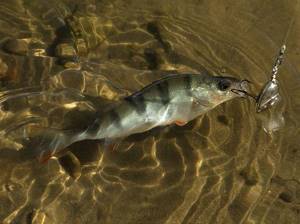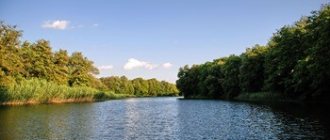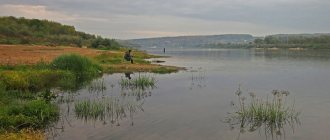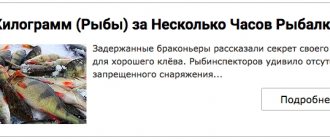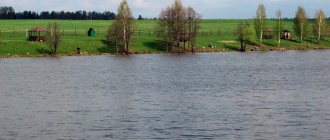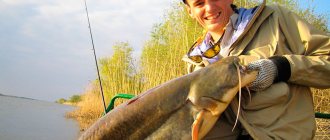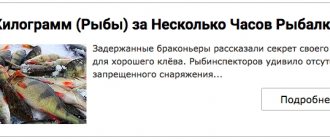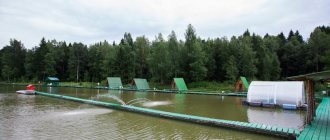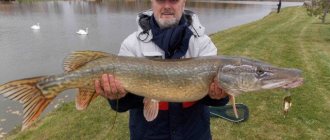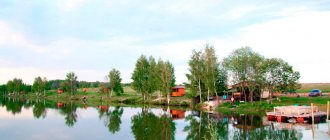What are the best places for fishing in 2018-2019
Of course, every fisherman has his own cool places, which can be indicated by the presence of fishing luck. However, you can still highlight the most popular of them. For fans of bream, the city of Kolomna is suitable. But some fishermen say that the largest specimens are worth looking for in the village of Kolychevo.
Other popular stops are Beloomutovskaya Platinum and Trinity Lakes. Unfortunately, the areas that flow directly in the city itself do not bring pleasure. But because poachers with nets are operating here. But you are allowed to cast the fishing rod further away from the confluence of the Moscow River. There is another city - Kashir. Here fishing takes place on a winding riverbed with rocky quarries and riffles.
You can find many predators here. However, there are also peace-loving fish species. The surroundings of the city of Serpukhov can be considered ideal for fishing. Almost all the fish are found here. There is a very high probability of catching luck by the tail near the rifts and braids. But the most famous places are the gaps between the road and railway bridges on the Warsaw Highway, which is located near the village of Lanshino.
As for winter fishing, the Kistrus oxbow is considered a popular area here. Here in winter you can catch pike, pike perch, bream or whitefish. In the homeland of the Russian poet Sergei Yesenin - near Konstantinovo, you will not be able to find deep and large holes. The abode of pike can be called the river clearing from the village to the junction of the Oka with the Krutitsa stream.
From spring to spring
If you want to catch fish such as bream, ide or roach on the Oka, then the best time for this will be spring. Local residents also recommend choosing islands that are located at the mouths of inflowing rivers, with reverse flow and in narrow spaces. The fish always linger here before leaving to spawn. When the second half of the last month of spring arrives, the spawned specimens are already returning to the main channel.
And then comes the season of long-distance casting. During the sultry summer heat, there is almost no bite during the day. The fish have to get up early in the morning or go fishing late in the evening. Some people prefer to fish at night. It is at this time of day that the clipper, silver bream, chub, white-eye of considerable size, roach and eye are awake. Sometimes even the bersh with pike perch doesn’t sleep. If we talk about bait, it is better to choose maggots and worms. Long-distance casting is still relevant. Wade fishing is also excellent.
Predators become active in the fall. From the end of the last month of summer, pike begin to bite. You can safely set baits for burbot and pike perch at night. It is best to place them along a watercourse. For autumn fishing, the most successful are receding coastal strips 2-3 meters deep with a measured flow or a shell-sandy bottom. As for the time of day, you need to choose from 6 to 10 am.
Winter fishing can also be productive. Experts advise arming yourself with a thin fishing line. In cold weather, do not forget about the danger - Oka can freeze unevenly, so the ice is only 18 cm thick. Do not forget to take life-saving equipment with you. You should not drill many holes in one area.
Secrets of fishing on the Oka
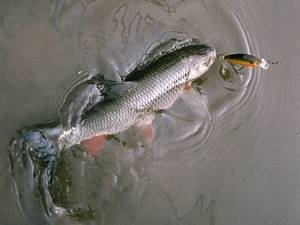
These are not caught every day, of course, but beyond Volgograd, anything over one and a half kilograms is already considered valid.
Fly fishing friends have found their fishing niche in that, rafting on mini rafts, they fish the most interesting places with the help of flies.
Among their main trophies are bleak, as large as herring, asp, sabrefish and, of course, chub.
Some individuals of the latter reach three and even four kilograms!
Such trophies are unattainable from the shore.
But you just have to put on a fly fishing raft and fins on your feet and float along the willow thickets hanging over the water, past the steep banks, casting the fly from the very edge of the shore or overhanging bushes to the depths, and the result will be such that the floaters and floaters who frequent this area will envy feeders.
Read the material “Across the Russian North. River rafting"
The upper reaches of the Oka, where I go from time to time with a light spinning rod, are interesting because the sandy islands end in pebble edges, and right there nearby there is a shallow riffle rippling over the clay edge.
Winding elongated holes are adjacent to shallow water, with miniature sand dunes, where growing fry love to frolic. And only on the Oka, for many kilometers, can you see long bridges leading from the shore into the water.
Opposite each of them, a little upstream at a distance of three to four meters, there are man-made fences. Every year, ice drift destroys these man-made creations. But at the beginning of the summer season they are restored again.
These are favorite places for floaters to meditate while waiting for a bite from the abundant bream and roach. Here on the shore you can find stationary houses - huts made of poles, covered with plastic film. Here, passionate fishermen while away the night and wait out the bad weather.
In August, coastal tree-nettle-willow thickets turn into impenetrable jungle. All bushes are entwined with wild cucumber vines with round, fluffy fruits. Here and there, feet get tangled in the strong ropey stems of red nightshade with ruby clusters of micro tomatoes.
The indignant whistling of young tits can be heard from different directions - here they find a table and a home. And no predator will get to them. Silvery threads of cobwebs, glistening in the sun, settle on clothes, faces, and gather in clubs on the rings of a spinning rod; these are small spiders traveling to places of future wintering. Alas, autumn is just around the corner.
Read the material “Preparing for the opening of duck hunting”
Experienced fishermen know that next season the channel will change its underwater geography. The spring water will smooth out the old sandy edges, cover newly brought snags with sand, wash new spits, and again you will have to find the key to fishing success.
For some it will be in the form of pike perch strikes on the far edge, for others - the careful night chimes of bells on donks or the whistle of an electronic bite alarm, and for others it will be in the form of a dead hook of Oka catfish, which they are increasingly trying to catch from a boat with a hook.
But all this trophy-spinning abundance is found downstream. There are deeper holes and more space on the water.
In the upper reaches of the river in the Tula region, the most common species found are chub, perch, pike, medium-sized asp and juvenile zander. But it is here that the chub is found in the form of trophy specimens. He loves such lands.
Tall herbs along the shore and large tracts of bushes and trees bent over the water supply chub flocks with a lot of insects throughout the summer season. And if you also take into account that in the sandy shallows numerous schools of fry fatten up, then these very places can be called a paradise for chub.
|
| Photo: Evgeny Kuznetsov. |
And what’s important is that not every fisherman is capable of a feat for the sake of an imaginary trophy, when you have to wade through the jungle, for fear of falling into a ditch dug by a beaver and breaking your legs. There is no need to wait for help here, don’t shout.
Read the material “Outfitting a mountain hunter”
There is one more inconvenience. Coastal thickets practically do not allow full casting from the shore. The most convenient way to travel here is by water.
Moreover, breathable fly fishing waders for these conditions are more comfortable than any wading boots. And you can go much deeper on the spits protruding towards the pits, and moisture from the body is pumped out through the membrane tissue, maintaining a comfortable state throughout the fishing day.
But most importantly, the less the body protrudes above the water, the less cautious the large fish is. But there are nuances here too.
All summer long, for successful fishing, bait could be placed under overhanging bushes, along vegetation islands, and even pulled into the water from sandy coastal slopes.
As autumn approaches, tactics change. Gone are the days of dry flies, mini-wobblers and micro-spinners. These baits are now most often attacked by small perch, pike - fingerlings and asps the size of a fork.
In calm, sunny weather, chub sometimes still attack surface baits, under overhanging bushes, like in the summer, but this is rather an exception to the rule. Because, following the grown-up fry, the big-faced predator moves to the pebble-sand spits and from the depths attacks the gaping fry, pressing it to the shallows.
Therefore, the most popular lures for spinning anglers will be light 4-5 centimeter wobblers with intense action, which, when retrieved, regularly “strike” along the sandy slope, raising clouds of turbidity.
Small “ratlins”, “shads” and two-piece “minnows” will be the most suitable baits.
At the end of summer the weather can be unpredictable and changeable. During the day, the sun can hide in the clouds many times and again hover in the blue sky. Light clouds or falling rain change the lighting in the water.
Therefore, the supply of baits and the color scheme of wobblers should take into account such changes. Or rather, take into account the chub’s whims.
As a rule, only medium-sized teenage chubs are ready to peck throughout the day, and their grandfathers prefer morning and evening dawns.
Read the material “Add to the asp”
Closer to autumn, veterans of chub flocks are ready to attack bait even at night. It is at this time of day that mice become active, and in search of new places they are ready to actively explore the aquatic environment, swimming from one shore to another, becoming easy prey for predators. And the chub is no exception here.
Last time we left the city under an approaching front. But the further from the city, the clearer the weather became. The mood was lifted, especially since the river greeted us with blue skies and bright sun.
Having been distributed among various promising places, everyone relied on their skills, the ability to read the river, the experience of previous fishing trips and, naturally, fishing luck. After some time we had to get together to discuss the results.
The chub was taken regularly, but only from one angler, on one edge and preferred the Duel ssminnow Yo-Zuri wobbler - blue with an orange belly and a series of dark dots along the body. He ignored all other baits, or occasionally knocked with his nose, while getting caught on the hook by the gill cover.
Small spoons and wobblers of other configurations were most often attacked by medium-sized perch, sometimes right at the feet.
|
| Photo: Evgeny Kuznetsov. |
We could only rejoice for our comrade, the lucky one who managed to find the right key to the chub’s whim. After lunch, the weather worsened before our eyes, and a light, tedious rain began to fall. The pecking stopped, but only for a while.
After the sun disappeared, the chub took a liking to a golden fry with a black zigzag along the body, or rather a wobbler of the same series, and from the same angler.
Standing next to each other, a few meters from each other, and throwing bait in the same direction, we only watched the next lucky trophy. And so on for almost an hour. The entire box of gear, or rather its contents, had already been tried, but the situation remained the same. And then the bite stopped for everyone.
Read the material “Antique hammer-fired clapper gun”
But, as it turned out, not for long. As soon as the sun appeared, the chub became active again, and again he gave preference only to the baits of the luckiest. It’s not for nothing that they say that if fishing didn’t calm me down so much, I would kill everyone...
Well, it's just some kind of magic. It began to rain again, the water bubbled from the impact of large drops, and after a while the river became muddy.
All. The bite is over.
On the way home, analyzing the situation out loud, the lucky man put forward his own version, and a very convincing one at that.
Our wobblers were a little lighter and smaller than his (which was true), and they passed over the fish, and the chub attacked only at the very bottom.
Then, having gathered together, we apparently also made noise to the fish, kicked up clouds of turbidity with our feet, so it moved deeper. And he decided to put wobblers of approximately the same color, but with a slightly larger blade. And he guessed right again and reached the fish.
But all these assumptions of ours will have to be checked only the next time we get to these places again.
Evgeny Kuznetsov August 22, 2021 at 06:07
Features of fishing on the Oka
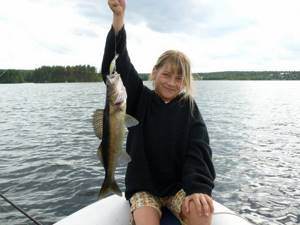
Since the Oka is a serious river, it requires respect. So you need to prepare thoroughly for the fishing itself. For example, choose floats, fishing rods, fishing line that will be able to cope with the rapid movement of the local waters. Even the hooks themselves must be selected taking into account the characteristics of a given body of water.
Fishing can be done both from a boat and from the shore. Here, fishermen use different gear: donka, spinning rod, lap dog, feeder or float rod. If we take into account Bolognese fishing, then a 7-meter rod is chosen. But why is it so big? Because in the expanses of water of a given reservoir, it is much easier and more convenient to cast a long rod over long distances, control and carry out the leash, and also control the fish near the banks or potential shelters.
Please note that the rod must be of high quality and balanced. You also need to take a landing net with a length of at least 4 meters. There should also be a monotonous fishing line with a diameter of 0.14 - 0.18 cm, a reel, drop-shaped floats that weigh from 4 to 15 grams. It is best to take floats with a metal keel and a more visible antenna.
Using a spinning rod also has its own characteristics. Due to the fact that fishing conditions can be varied, and the depth of the bottom, the strength of the water flow, the casting distance, the types and weights of bait will also be different, you will not be able to get by with just one tackle. So you will have to take a wide variety.
Fishing on the Oka in the Ryazan region: reports, bases, places
The Ryazan region is rich in fish resources. This is not least due to the numerous water arteries, of which the Oka stands out. The Oka is a large waterway that is rich in various river fish.
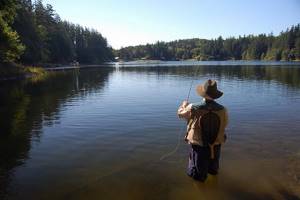
The fact that the region has good ecology and numerous water branches, mainly rivers, attracts fishermen from all over the central part of Russia. This was facilitated by the development of wild fishing, as well as a network of bases with a fishing focus.
The region itself has several large rivers, which are of course smaller than the Oka, but also have a large basin:
In total, there are more than eight hundred rivers in the Ryazan region, many of which belong to the Oka basin, which has led to fish diversity in the main artery.
There are many places for fishing holidays in Russia, for example, paid fishing in the Nizhny Novgorod region.

